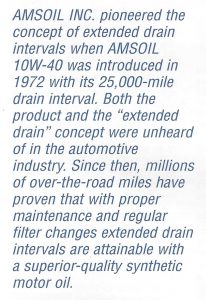The following article appeared in the AMSOIL Action News Dealer Magazine in April of 1994. At the time of this article, AMSOIL had been promoting extended drain intervals for 22 years, now 47 years after the introduction of AMSOIL, some people are still “emotionally” tied to the 3,000 mile oil and filter change.
Spearheading the move toward extended drain intervals has been large truck fleet operators. As maintenance costs have soared in recent years, many operators are looking at extended drains as a practical means to save money. A recent study conducted by John Martin, Field Testing Manager for Lubrizol Inc., supports AMSOIL’s long standing position on extended drain intervals, acknowledging that truck fleet operators, original equipment manufacturers (OEMs) and government agencies can all benefit from extended drains.

In his study, Martin observed that extended drain intervals can be attained, but only with quality oils. He also noted that fleet operators, in particular, are willing to pay more initially for high-quality lubricants if the end result will be lower maintenance costs through extended drain intervals. “One large fleet operator with 6,500 units has agreed to pay more for an oil proven to allow an extension in oil change intervals,” he said. “Estimated annual savings for this particular operator will exceed $1 million.”
Extended drain intervals reduce two types of costs for truck fleet operators: actual oil change costs and oil disposal costs. Typical oil change costs include the price of the oil, filters and labor. Depending on the location, total cost for one oil change using a petroleum motor oil for a tractor/trailer can range between $60 to $70. With petroleum products, oil changes for a large fleet can easily run into thousands or even millions of dollars per year. Oil disposal costs include the storage and disposal of used oil. Fleets sometimes have to commission underground storage tanks to house used oil and install expensive leak detection systems. Significantly extending drain intervals allows operators to schedule maintenance at fewer, more well-equipped facilities and to de-commission older storage facilities.
Automotive and equipment OEMs, once against the idea of extending drain intervals, are now seriously looking into the advantages. Certain European vehicle manufacturers, including Mercedes-Benz, have endorsed extended drain intervals based on oil quality. One advantage that OEMs find especially attractive is the opportunity to promote certain extended warranty programs.
Martin also mentioned in his study that government agencies are receptive to the idea of extended drain intervals. The government sees increasing oil drain intervals as one way to reduce our country’s dependence on foreign crude oil. Also, the problem of used oil disposal has been a major concern for the government for several years. A sound program to decrease the amount of used oil would help in meeting the objectives of agencies like the Environmental Protection Agency.
AMSOIL Synthetic Motor Oils epitomize the term “high-quality lubricant.” Their benefits far outmatch those for any other motor oil. At any drain interval, AMSOIL is superior to its competitors. What has always made AMSOIL Motor Oils unique, though, is their 25,000-mile drain interval. With its TRIGARD System, AMSOIL has advanced the concept of extended drain intervals farther than any other oil company ever imagined. In the past, many automotive and lubricant experts were reluctant to endorse synthetic motor oil and extended drain intervals, but not anymore. For example, Dr Robert Shubkin of Ethyl Corporation states in Lubrication Engineering, March 1994, that high quality synthetic oils “can be used for longer drain intervals provided filters are adequate to avoid accumulation of other debris.” With the increased engine demands and the stricter environmental regulations placed on today’s vehicles, the introduction of AMSOIL 10W-40 1 and the concept of extended drain intervals over twenty years ago illustrates once again why AMSOIL is “The First in Synthetics.”
1 While 10W40 motor oil was the recommended motor oil for most vehicles when AMSOIL introduced it in 1972, it is no longer the recommended viscosity for modern vehicles. To find the correct lubricants and filters for your vehicle and/or equipment, check the AMSOIL Lookup.
